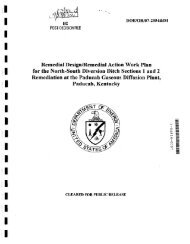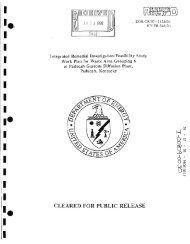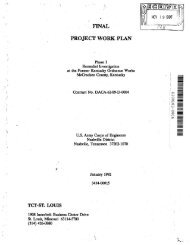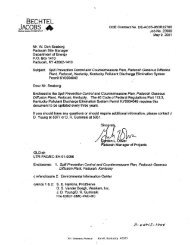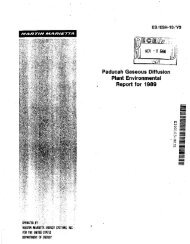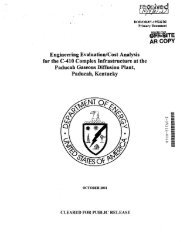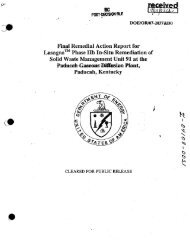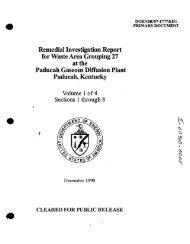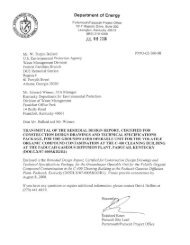1 - paducah environmental information center
1 - paducah environmental information center
1 - paducah environmental information center
Create successful ePaper yourself
Turn your PDF publications into a flip-book with our unique Google optimized e-Paper software.
Annual Site Environmental Report for 1999<br />
Table 6.1 shows internal dose factors for<br />
several radionuclides of interest at the Paducah<br />
Site. These factors are used to determine the<br />
CEDE to an adult.<br />
Direct Radiation<br />
In 1999, DOE conducted continuous<br />
monitoring. for direct external radiation exposure<br />
(Section 5~. 'The monitoring results indicate that,<br />
due to inaccessibility of the public to radioactive<br />
source areas, the dose to the maximally exposed<br />
individual member of the public (Le., the<br />
neighbor living closest to the PGDP security<br />
fence) from DOE operations did not. vary<br />
statistically from background (Le., was essentially<br />
zero) (BJC 2000b).<br />
For purposes of this annual <strong>environmental</strong><br />
report, an additional potential receptor was<br />
considered. This receptor is assumed to<br />
frequently travel along Dyke Road in the vicinity<br />
of location TLD-25 (Figure 5.4). A very<br />
conservative exposure scenario assumes<br />
occupancy for the maXimally exposed receptor<br />
at this location in 1999 to be 100 hours based on<br />
an individual driving past this location twice per<br />
day at 12 minutes per trip, five days per week, 50<br />
weeks per year. The mean dose rate for location<br />
TLD-25 , attributable to the Paducah Site, was<br />
determined to be 0.00137 mremlhr (BJC<br />
2000b). Therefore, the dose to this receptor is<br />
calculated at 0.137 mrem for 1999. It is worth<br />
noting that actual occupancy at this location is<br />
probably very less than assumed and that any<br />
shielding from the receptor's vehicle is not<br />
considered. Furthermore, even if the receptor<br />
were assumed to have occupied this site for 365<br />
days, 24 hours per day in 1999, the total dose<br />
received would have been approximately 12<br />
mrem, well below the DOE 100 mrem limit to<br />
members of the public.<br />
Surface Water<br />
The most common surface water pathwl.lY·<br />
for exposure is through drinking water<br />
containing radionuclides. A drinking water<br />
pathway dose was calculated in 1999 for an<br />
individual assumed to consume water from the<br />
public drinking water supply at "Cairo, Illinois.<br />
Cairo is the closest drinkW~ water system that<br />
uses water downstream of PGDP effluents.<br />
Stream concentrations of radionuclides were<br />
Table 6.1 Internal Dose Factors for an Adult<br />
Intake" (mremlpCi)<br />
Inhalation<br />
Half-life Inhalation (slightly Inhalation<br />
Isotope (years) (soluble) soluble) (insoluble) Ingestion<br />
234U<br />
240,000 0:0027 0;0071 0.13 0.00026<br />
23SU<br />
710;000,000 0.0025 0:0067 0.12 0.00025<br />
238U<br />
4;500;000,000 0.0024 0:0062 0.00023<br />
99'Fc . 210,000 0.00000084 0.0000075 0.12 0.0000013<br />
237<br />
Np 2,100,000 0.49 0.0039<br />
239pU 24,000 0.51 0.33 0.0043<br />
2~ 75,000 0.32 0.26 0.00053<br />
Source: U.S. DOE. July 1988. Internal Dose Conversion Factors/or Calculations<br />
o/Dose to the Public, DOElEH-0071.<br />
Dose<br />
6-3



